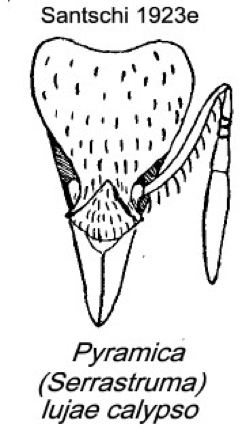Pyramica (Serrastruma) lujae
(Forel)
  Type location Mozambique
(Strumigenys Lujae n. sp., Forel, 1902e: 294, illustrated,
worker; footnote in Wasmann, 1902) collected at Morumballa, on the
Zambezi River, by E. Luja - see below Type location Mozambique
(Strumigenys Lujae n. sp., Forel, 1902e: 294, illustrated,
worker; footnote in Wasmann, 1902) collected at Morumballa, on the
Zambezi River, by E. Luja - see below
junior synonyms
aequalis (Strumigenys
(Cephaloxys) aequalis n. sp., Menozzi, 1942: 177, worker &
queen) from Fernando Po I. - no images on Antweb (February 2015)
calypso (Strumigenys
(Cephaloxys) calypso n. sp., Santschi, 1923e: 288, illustrated,
worker) from Tanzania, Ouha, Meyer - see http://www.antweb.org/specimenImages.do?code=casent0912837
gerardi (Strumigenys
(Cephaloxys) Gerardi n. sp., Santschi, 1923e: 287, worker) from Zaďre,
Mongende, Dr Schouteden - see http://www.antweb.org/specimenImages.do?code=casent0912838
glanduscula (Strumigenys
(Cephaloxys) glanduscula n. var., Santschi, 1919h: 88, worker)
from Zaďre, Yambuya, J. Bequaert - see http://www.antweb.org/specimenImages.do?code=casent0912839
reticulata (Strumigenys
reticulata n. sp., Stitz, 1910: 141, worker) from Cameroun,
Bibundi, Tessman - no images on Antweb (February 2015)
(see Bolton, 1995)  . .
|
 WORKER - TL 2.2-3.3
mm;
characters as in key; note variable size; colour yellow to medium-brown
(Bolton, 1983, illustrated, alitrunk and pedicel profile). WORKER - TL 2.2-3.3
mm;
characters as in key; note variable size; colour yellow to medium-brown
(Bolton, 1983, illustrated, alitrunk and pedicel profile).
A mainly forest species found throughout
sub-Saharan Africa, with many records (Bolton, 1983).
Brown (1952) also reported specimens as found in Honolulu (Hawaiian
Plant Quarantine) and Saő Tomé.
Specimens in the CRIN collection were labelled as
from CRI, Ghana, although Bolton (1983) noted that
he collected it in Nigeria, at CRIN.
From Ghana, at CRIG (C.A.
Collingwood; B. Bolton), Aburi and Mamfe Scarp (D. Leston), and
Bolgatanga (E.S. Ross & K. Lorenzen) (Bolton, 1983). Found on
cocoa at Kade by Majer (1975); from cocoa mistletoe (Room, 1975). Since
collected from leaf litter (802 workers) in the semi-deciduous forest
zone, under cocoa at Juaso, primary forest at Esukawkaw Forest Reserve
and Atewa Forest Reserve, by Belshaw & Bolton (1994b).
From Ivory Coast in Banco
Forest (I. Löbl; W.L. Brown), at Man (I. Löbl; V.
Mahnert & J.-L. Perret), at Yapo Forest, Agboville (I.
Löbl), Anguédédou Forest (W.L. Brown)
and Sangrobo (W.L. & D.E. Brown).
Cameroun records include
Batanga (G. Schwab), Mt. Cameroun (L. Fea, perhaps in 1901; B. Malkin),
Nko'emvon (D.A. Jackson) and near Yaoundé (G. Terron).
Bernard (1952) recorded a Guinea,
finding of a single worker (as Strumigenys (Cephaloxys)
glanduscula) from Mt. Nimba, Nion, 700 m; "different from the
type (Belgian Congo) by being shorter and with the spines twice as
long". He separated it from a specimen of bequaerti
(see above).
Nests in dead wood on living trees, foraging there
and in leaf litter. Bolton (1983) relates a letter from W.L. Brown, in
which the habit of preying on collembolans was vividly described, no
other insects were seen as prey. Déjean & Benhamou
(1993) described how the workers search individually for collembolans
in the leaf litter of humid tropical forests. The core of their paper
was a laboratory study of the orientation and foraging movements in a
patchy environment, similar to that found in the dry season in the
forests, when collembolans congregate in wet patches of leaf litter.
|